This vegan kimchi is easy to make, completely vegan friendly, and tastes just like regular napa cabbage kimchi! It's perfect for eating as a side while fresh and once it's well fermented, it'll be mouthwateringly tangy, which is still perfect as a side but also great for making kimchi jjigae, kimchijeon (kimchi pancakes), and this super easy and addictive 10-minute kimchi chili oil ramen! We've included step by step instructions with photos below to guide you through the process.

If you’ve made this recipe or any recipes from our blog, please tag us on Instagram using #twoplaidaprons! You can also tag us in your Instagram stories using @two_plaid_aprons. We would love to see your creations! It absolutely makes our day! 🥰
Jump to:
Difference between regular kimchi and vegan kimchi
Traditional kimchi usually uses fish sauce and saeujeot (Korean fermented salty shrimps). This is the secret ingredient for all the umami and funk in traditional kimchi. It's also what seasons the kimchi marinade and helps with kimchi's fermentation process.
In our vegan kimchi recipe, we omitted both the fish sauce and saeutjeot. Instead, we opted for a little additional salt and our secret ingredient – mushroom powder. It's packed with umami flavor, which is exactly what we're missing from omitting fish sauce and saeujeot. Do note: Not all mushroom powers are made equally and some are not vegan friendly. So make sure to read the label!

Ingredients needed for making vegan kimchi
Please scroll down to the recipe card for the ingredient quantities!
For the bulk of the kimchi:
- Napa cabbage - The main star of this classic kimchi! Napa cabbage is usually available at most Asian markets and even at local grocery stories. But the price is definitely better at Asian markets.
- Salt - We highly recommend using Kosher salt or any coarse salts. Coarser salts are easier to control when salting.
- Carrot and Korean radish - Both add flavor, mild sweetness, and extra texture. For the Korean radish, it can be found at most Asian markets. These radishes are the thicker ones with white and green skin. If you can't find Korean radish, daikon radish is a good substitute or you can simply omit it.
- Buchu - Also known as Asian chives. They really bring the FUNK to kimchi, which we highly recommend adding since our vegan kimchi won't have the usual funkiness from fish sauce and saeujeot. If you cannot find any buchu, feel free to use green onions instead.

For the vegan kimchi marinade:
- Rice flour and water - These two ingredients are cooked into paste that makes the marinade stickier so that the marinade can adhere to the napa cabbage. You can use either regular rice flour (red bag) or glutinous rice flour (green bag).
- Gochugaru - Also known as Korean red pepper flakes. Make sure to get the coarse gochugaru. The fine version is too fine for kimchi. Also, some Korean markets offer different varieties of gochugaru that differ in spice level. You can choose the one that you prefer.
- Yellow onion, garlic, ginger - These are the base flavors of the marinade. They also add spiciness to the kimchi.
- Apple or Korean pear - Either fruit is good fine. They serve as a natural sweetener and provide some extra liquid for the marinade. If using apple, we recommend juicy apples, like Fuji.
- Mushroom powder and salt - These two ingredients are the substitutes for fish sauce and saeujeot (fermented salty shrimps) that's normally use in making regular kimchi. The mushroom powder gives the marinade the extra touch of umami while the salt makes up for the saltiness needed.

How to make the BEST vegan kimchi
Please scroll down to the recipe card for the full recipe and instructions!
Clean and cut the napa cabbage:
1. Peel away and discard any undesirable outer layer leaves of the napa cabbage.
2. With the napa cabbage laying on its side, quarter the cabbage long ways. You can also just cut the stem area of the cabbage and rip the rest of the cabbage open with your hand. Repeat with remaining napa cabbage.




3. Trim away excess part of the cabbage core but not too much so that the leaves can stay intact. Then, rinse between each leaf to remove dirt or grim. Make sure to pay extra attention to the outer few leaves. Drain the cabbages as best as you can.
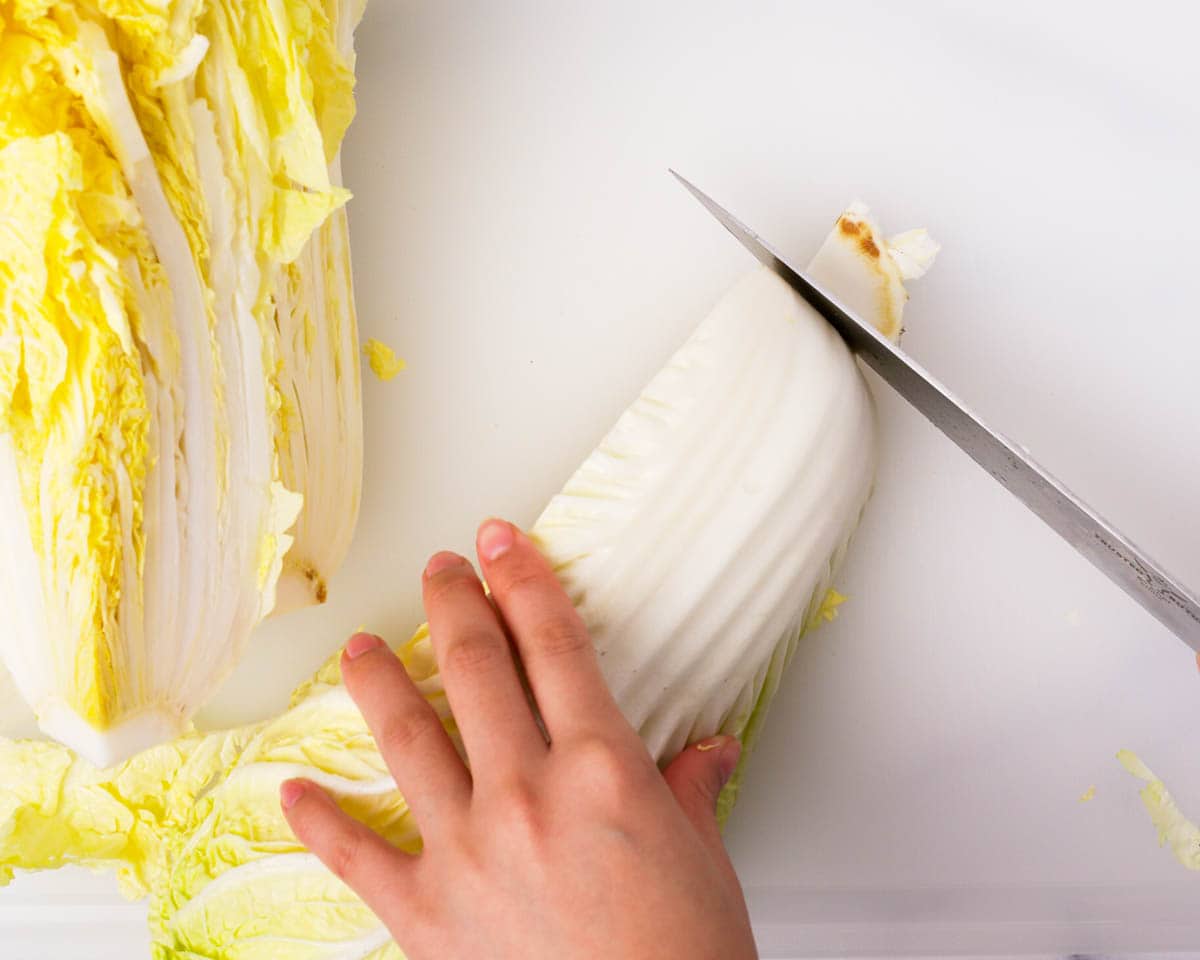
Salt the napa cabbage:
4. In a clean, sanitized area (like a large bowl in a clean sink), salt each quarter of napa cabbage by sprinkling salt between each and every layer and from the root to the tip of each leaf. Make sure to salt more generously around the stems. Repeat with all cabbages.

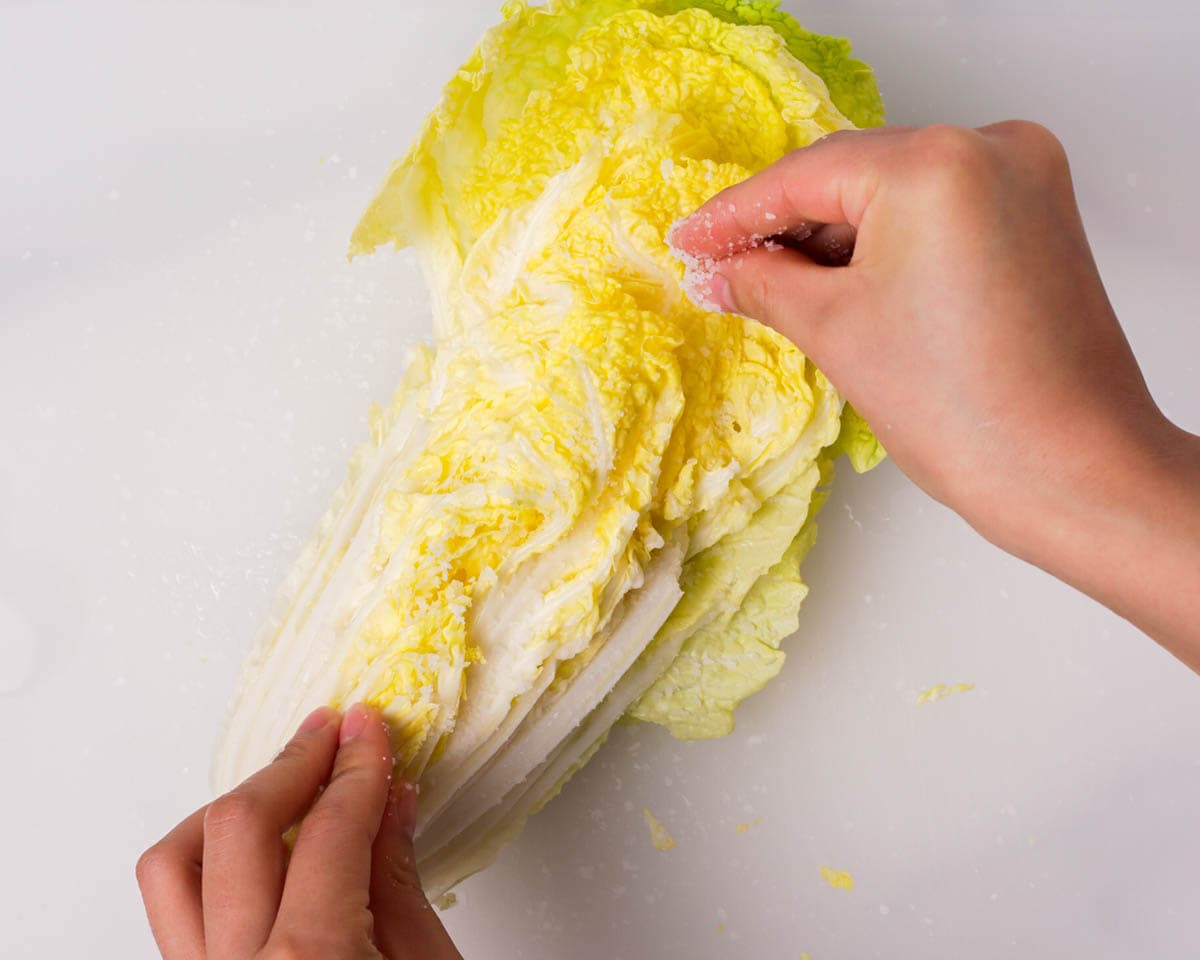
5. Once all of the cabbages are salted, arrange and stack them in a large bowl. Cover and weigh down the cabbages with something heavy and let them salt for 1½ to 2 hours. Rotate the cabbages every 30 to 60 minutes, moving the ones on the top to the bottom.



6. To check if the napa cabbage is done salting, rip off a small leaf of cabbage and rinse it well with fresh water. Taste the cabbage. The cabbage will be very bendable and should taste well seasoned at the stem, while the leaf should be a littler saltier but not unbearable. If the cabbage does not taste salted enough, continue with the salting process for another 30 minutes to 1 hour, until the desired saltiness is achieved.

7. Once the napa cabbages are done salting, rinse the them with fresh water to remove excess salt. Make sure to get between each leaf.
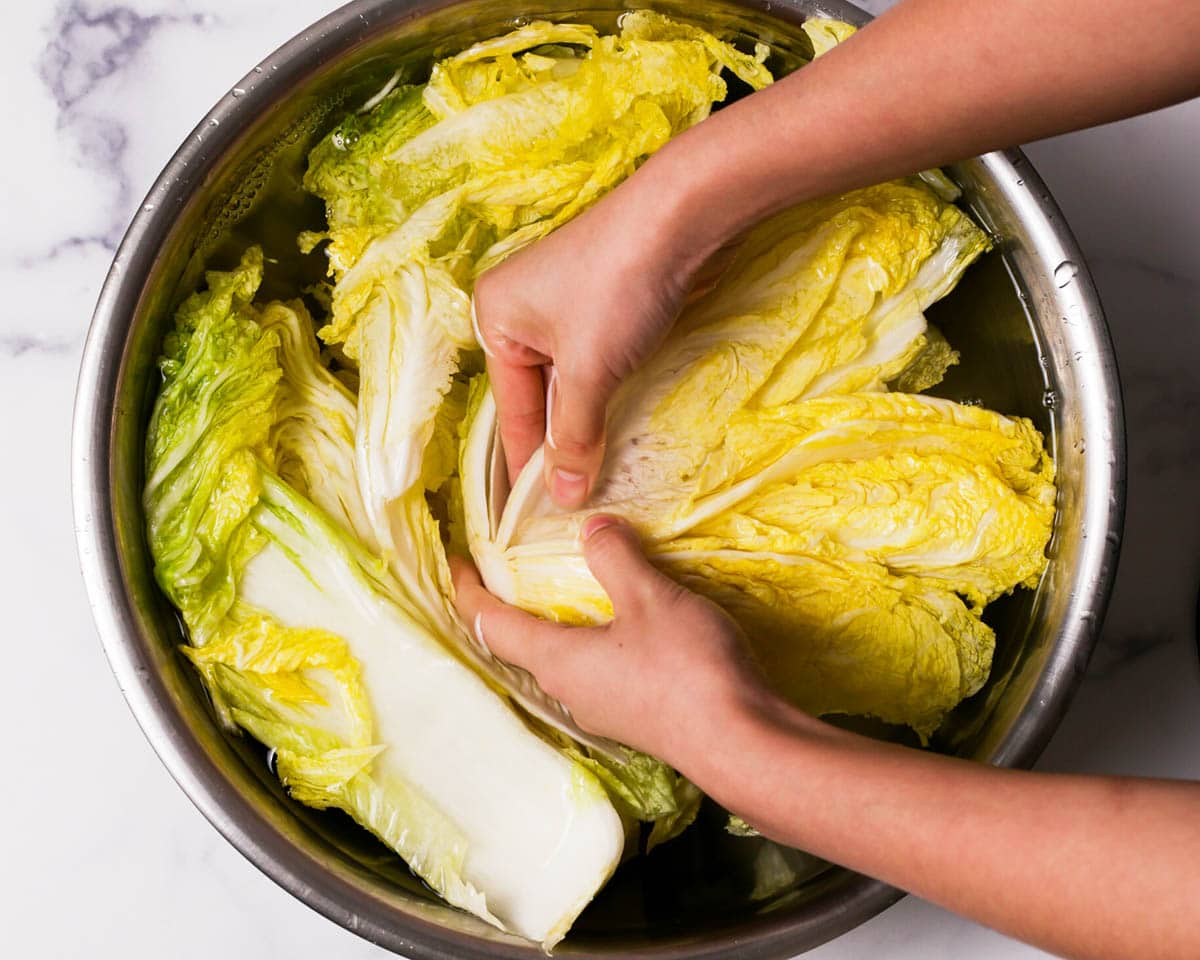
🌟 Pro tip: We like to rinse our napa cabbage in a large bowl of water and repeating the process about 2 to 3 times with fresh water. We recommend tasting the cabbage after the final rinse to see if the cabbage require an additional round or two of rinsing.
8. After the final rinse, gently but firmly squeeze each quarter of napa cabbage to remove most of the excess water, especially the leafy parts. But don’t squeeze too hard or the stems may get bruised and damaged. Removing the excess water helps to prevent the marinade from becoming diluted and watery.

Make the kimchi marinade:
9. While the napa cabbages are salting, make the marinade. First, make the rice flour paste by whisking together the rice flour and water until well combined. Transfer the mixture to a pan or saucepan and cook over medium to medium high heat, stirring occasionally. Once the paste starts to thicken, stir constantly until the a thick, bubbly, slightly translucent paste forms. Transfer to a large mixing bowl and let cool.

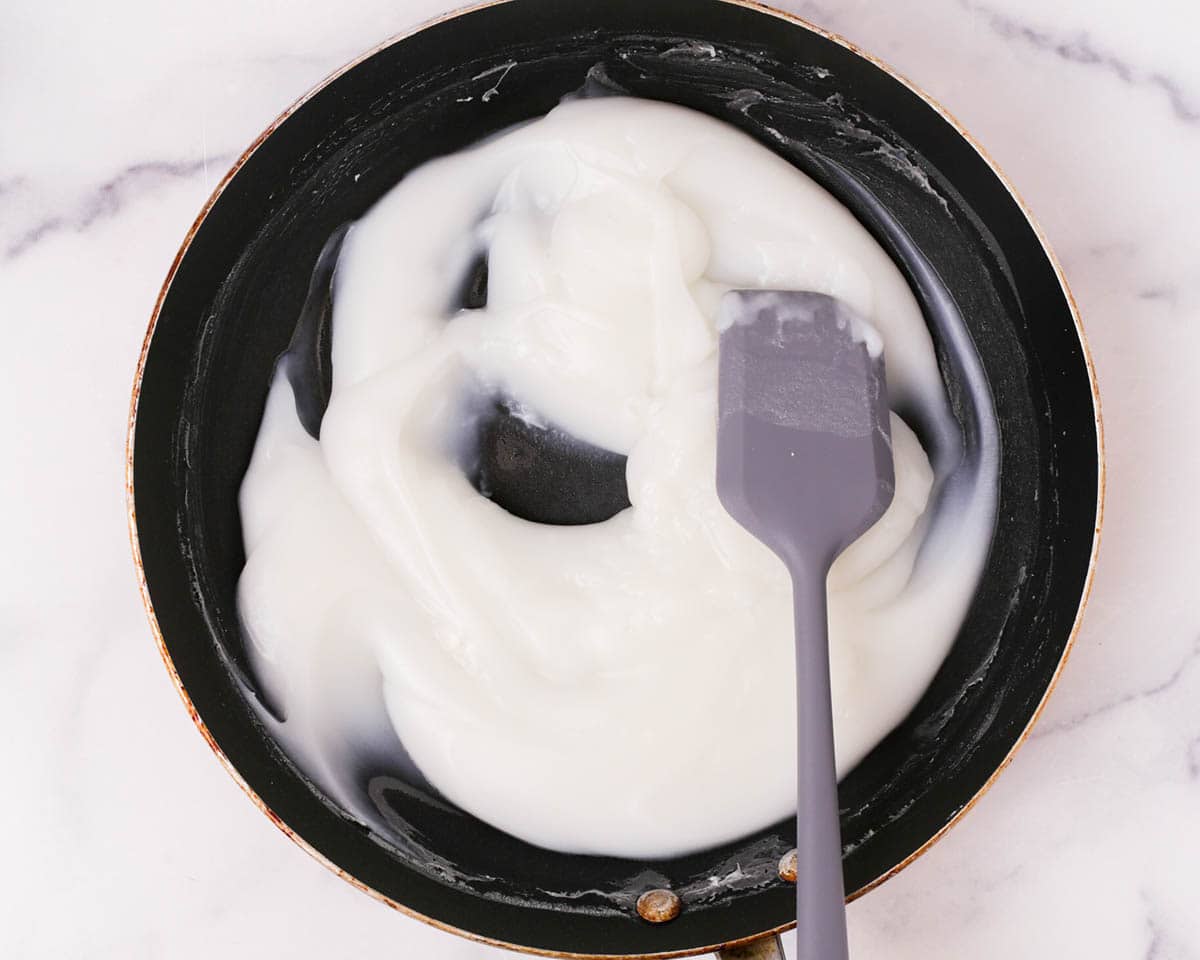
10. In a blender, add the apple or pear, onion, garlic cloves, ginger, mushroom powder, and salt. Blend everything together until the mixture well combined. Add half of the gochugaru to the mix and blend until well combined and as smooth as possible. Scrap down the sides as needed.

11. Transfer the mixture to the bowl with the cooled rice flour paste, along with the rest of the gochugaru, Korean radish, carrot, and Asian chives. Mix until evenly combined. Set aside until needed

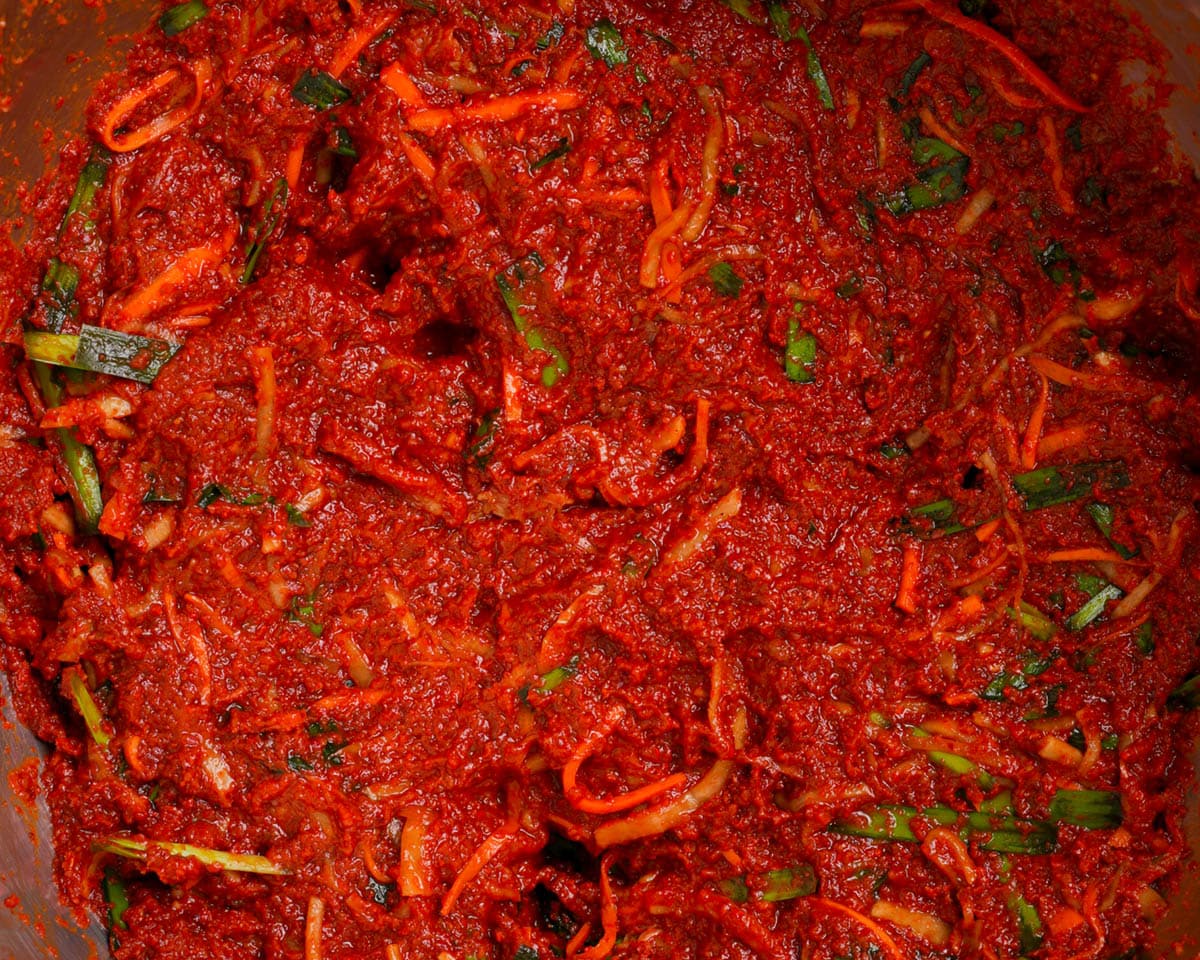
Marinate the napa cabbage:
12. Working with gloved hands and one quarter of napa cabbage at one time, place the cabbage in the bowl of prepared kimchi marinade. Take some marinade and rub it on each leaf. Make sure to also leave some of the julienned veggies in between each layer too!

13. Once the entire quarter of cabbage has been rubbed down with marinade, fold the cabbage over itself to keep it tight. Repeat with remaining cabbage.

14. Pack the kimchi into sterilized glass jars or BPA free plastic kimchi containers. Make sure to pack the cabbage tightly into the container, but leave at least 1 inch of space between the top of the kimchi and the lid. As the kimchi ferments, it will release juices and produce gas. The extra room will help prevent the kimchi from popping off the and the juices from overflowing.

🌟 Pro tip: If storing in a kimchi tote, place a sheet of cling film on the kimchi. Make sure to tuck the cling wrap in and that the cling wrap is touching the kimchi. This helps to prevent excessive oxidation.
15. The napa cabbage kimchi can be enjoyed immediately after marinating, after chilling, or you can let it ferment until it reaches your desired fermentation stage before eating or used in cooking.

Recipe tips
- Use Kosher salt or coarse salt to salt the napa cabbage. Coarser salt is easier to sprinkle, and it's easier to gauge how much salt is used and control the saltiness.
- Wear disposable gloves when slathering the marinade onto the salted cabbages. The marinade will stain your hands and anything it touches.
- Use weights to help the napa cabbage salt faster. The weight helps to compress the cabbage, which ensure the leaves are in contact with the salt so that osmosis does its thing. We like to stack heavy books on a clean plate or bowl.
- Leave at least an inch gap in the kimchi container. The gap is to compensate for the expansion the kimchi will undergo during fermentation. The amount of juices will increase too. If you do not leave enough room or eat enough as the kimchi ferments, it will overflow and leak from the containers.
Alternative method to salt the napa cabbage
Traditionally, kimchi is made with quartered or cabbages cut in half. This is so that the kimchi can last longer because the less surface area that's expose the slower the fermentation process will work. Likewise, the more surface area exposed, the quicker things ferment.

So if you want to ferment your vegan kimchi faster, you can cut and salt it like in our fresh kimchi (geotjeori) recipe. Then follow this kimchi marinade recipe as is but you can simply mix the salted cabbage with the marinade instead of slathering each leaf one by one..
This alternative method is much less labor intensive process than the traditional method, but because the cabbage is cut into smaller pieces, it'll become fermented much quicker and will stay good for a shorter amount of time.

Storage
This vegan kimchi can be enjoyed right away, but if you prefer it sour and fermented, let it sit at room temperature for a day or two to speed up the fermentation process. Then, keep it refrigerated at all times. The fermentation process usually takes about 1 to 2 weeks for vegan kimchi since there's not fish sauce and saeujeot in the marinade.
You can also transfer the kimchi to the fridge right away once you're done making it, if you prefer a slower fermentation and want to enjoy the taste of fresh kimchi for a little longer.

Make sure the kimchi is stored in clean, sterilized glass jars. We often store our kimchi in the gallon glass jars we saved from store-bought kimchi or in quart size mason jars. You can also store kimchi in clean BPA-free plastic containers, but do let me warn you. The container will most likely be stained orange and will forever smell like kimchi. So make sure to use a container you want to dedicate to storing kimchi.
Lastly, make sure to press down on the cabbages and try to keep them tightly packed together. Do this every time the kimchi is used. This prevents the kimchi from being exposed to a lot of oxygen, which could cause it to oxidize and spoil sooner.
🌟 Pro tip: We also recommend double and triple wrapping the container in a few layers of plastic bag. This is especially helpful if you are storing the kimchi in the same fridge as other groceries. Otherwise, the smell will for sure permeate into everything.
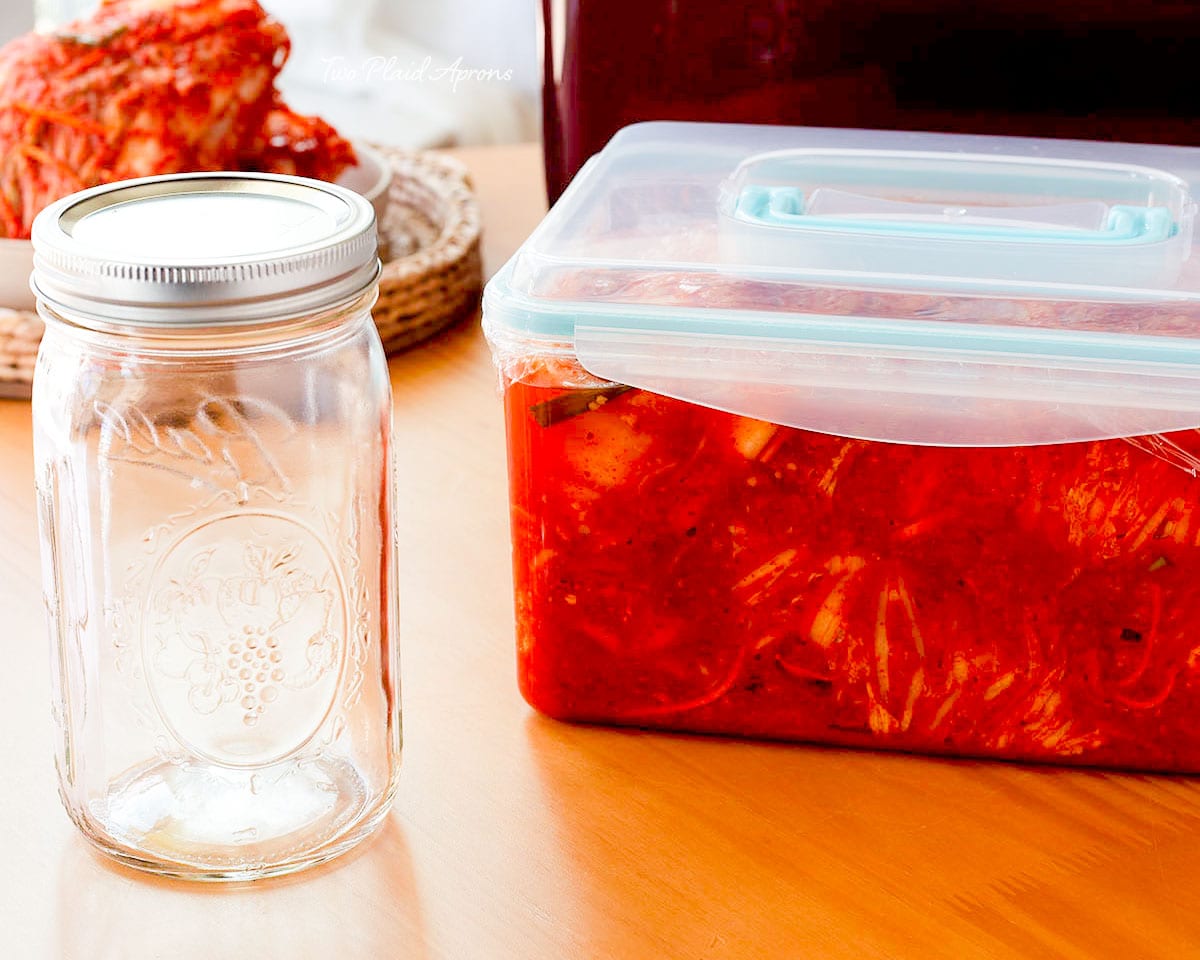
How to sterilize jars
The easiest way to sterilize your glass jars or canning jars for your is by boiling them. Just bring a pot of water to a boil and gently submerge the jars into the water completely. Let them simmer for 10 minutes for altitudes of 1000 feet or less and add an additional minute per 1000 feet.
Alternatively, if you are using those gallon size jars, you can place the jar upside-down into a pot or pan of simmering water. Let the jars steam for about 15 minutes.
🌟 Pro tip: Place a rack at the bottom of the pot or pan to prevent the jars from having direct contact with the heat and to precent the constant clanking.
Once they are done boiling or steaming, carefully remove the jars and let them cool and dry completely before using.

FAQ
Kimchi can technically be preserved forever, if not, at least 6 months. However, it all depends on whether it was properly salted, prepared and stored. If your kimchi smells sour or tastes sour and fizzy, that is totally normal. That means it is fermenting well. However, if your kimchi is showing signs of molding or discoloration (turning really dark), it would be wise to discard it.
Unfortunately, no. Gochugaru, or Korean red pepper flakes, have a very particular flavor that does not taste like regular red pepper flakes. We highly recommend against using regular red pepper flakes.
If the kimchi was properly salted, prepared, and stored, it should last up to 6 months, or even a year. Do note that, as the it ferments, it'll go from sweet, to kind of sour, and to very sour and bubbly. Sour and bubbly kimchi is perfect for cooking!
📖 Recipe
Vegan Kimchi
Ingredients
To salt the napa cabbage:
- 1 head napa cabbage average 4 lb/1800g per head
- Kosher salt about 1 cup or as needed for salting
For the vegan kimchi marinade:
- 1 cup water
- ¼ cup rice flour regular or glutinous
- ½ large apple discard core and cut into smaller chunks (fuji, honey crisp, and gala are good choices or use Korean pear) *see notes
- ½ medium yellow onion peeled cut into smaller chunks
- 15 cloves garlic trimmed
- 1 inch knob of ginger peeled and cut into smaller pieces
- 1 tablespoon mushroom powder
- ½ tablespoon kosher salt
- 1 cup gochugaru (coarse) divided (also known as Korean red pepper flakes)
Additional vegetables for kimchi:
- 8 ounces Korean radish peeled and julienned
- 4 ounces carrot peeled and julienned
- 3 ounces Asian chives cut into 1 inch pieces and discard about 1 to 2 inches of the tough stem (green onion is okay too) *see notes
Instructions
Clean and salt the napa cabbage:
- Peel away and discard any undesirable outer layer leaves of the napa cabbage.
- With the napa cabbage laying on its side, quarter the cabbage long ways. You can also just cut the stem area of the cabbage and rip the rest of the cabbage open with your hand. Repeat with remaining napa cabbage.*Please refer to the post above for photo reference.*
- Trim away excess part of the cabbage core. Then, rinse and wash each quarter of the napa cabbage with water to remove dirt or grim. Make sure to pay extra attention to the outer few leaves. Drain the cabbages as best as you can.
- In a clean, sanitized area, salt each quarter of napa cabbage by sprinkling salt between each and every layer of leaves. Make sure to salt more generously around the stems.
- In a clean, sanitized area, salt each quarter of napa cabbage by sprinkling salt between each and every layer of leaves. Make sure to salt more generously around the stems. Arrange and stack the cabbages in a large bowl. Cover and weigh down the cabbages with something heavy and let them salt for 1½ to 2 hours. Rotate the cabbages every 30 minutes, moving the ones on the top to the bottom.
- To check if the napa cabbage is done salting, rip off a small leaf of cabbage and rinse it well with fresh water. Shake off and gently squeeze the cabbage to remove excess water and taste the cabbage. The cabbage will be very bendable and should taste well seasoned at the stem, while the leaf should be a littler saltier but not unbearable. If the cabbage does not taste salted enough, continue with the salting process for another 30 minutes to 1 hour, until the desired saltiness is achieved.
- Once the napa cabbages are done salting, rinse the them with fresh water to remove excess salt. Make sure to get between each leaf. *We like to rinse our napa cabbage in a large bowl of water and repeating the process about 2 to 3 times with fresh water. We recommend tasting the cabbage after the final rinse to see if the cabbage require an additional round or two of rinsing.*
- After the final rinse, gently but firmly squeeze each quarter of napa cabbage to remove most of the excess water, especially the leaves are. But don’t squeeze too hard or the stems may get bruised and damaged.
For the vegan kimchi marinade:
- The kimchi marinade can be made while waiting for the cabbage to salt.First, make the rice flour paste. Whisk together the water and rice flour until well combined and no more clumps are visible. Transfer the mixture to a pan or saucepan and cook on medium to medium high heat until the mixture thickens into a translucent paste. Stir occasionally in the beginning and once the mixture starts to thicken, stir constantly. Transfer the paste to a large mixing bowl to cool.
- In a blender, add the apple, onion, garlic, ginger, mushroom powder, and salt. Blend until smooth and everything is well combined. Scrape down the sides as needed and add half of the gochugaru. Blend until well combined and as smooth as possible. Transfer to the mixing bowl with the rice paste and also add the remaining gochugaru.
- With gloved hands, mix the paste until everything is well combined and evenly coated. Then add the Korean radish, carrot, and Asian chives. Mix well and set aside until needed.
Marinate the salted napa cabbage:
- With gloved hands, work with one quarter of a napa cabbage at a time. Place the cabbage in the bowl of prepared kimchi marinade and generously slather the marinade (with the veggies) in between each leaf of the cabbage. Fold the cabbage over itself and pack it into sterilized glass jars or BPA free plastic kimchi containers. Repeat with remaining napa cabbage.*Keep about ½ to 1 inch of space between the top of the kimchi and the lid to allow room for expansion during fermentation.*
- This vegan kimchi can be cut and enjoyed immediately for fresh tasting kimchi or let it ferment for about 1 week or until sour for the classic tangy, funky flavors. You can even let the kimchi sit out at room temperature for 1 to 2 days before refrigerating to help speed up the fermentation process.
Notes
- Korean pear - We often switch between using apples or Korean pears in the kimchi marinade. It's essentially a natural addition of sugar and extra water content. If using Korean pear, make sure to peel the skin and discard the core.
- Make sure to wear disposable gloves when applying the marinade onto the napa cabbage. The marinade will stain your hands.
- Asian chives - These chives is part of what makes kimchi funky. You can find it at most Asian markets. If you prefer, you can use green onions instead. The whole green onion can be used. For the white part of the green onion, cut it in half lengthwise.




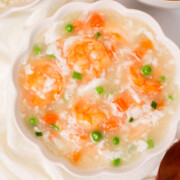



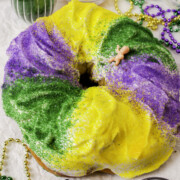


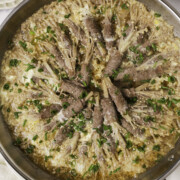








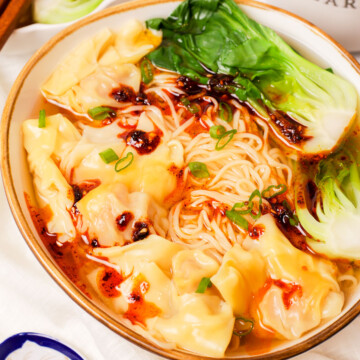

SS says
Hi,
I made the vegan kimchi for the first time today. I accidentally added extra onion so the kimchi now has strong onion taste. Is there a way to nuetralise the onion taste? Or will it settle once the kimchi ferments?
Mei says
Hi there! Thank you for trying out our vegan kimchi recipe! Unfortunately, there's not really a way to neutralize the onion flavor. However, as the kimchi ferments, the flavor will mellow out a bit.
Mei ❤️
SS says
Could I add lemon juice or rice vinegar to the vegan kimchi to reduce the raw onion taste?